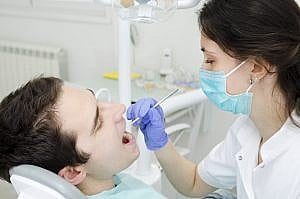 Gum disease is a fairly common dental problem among adults. Chronic gum disease affects 47.2% of adults over the age of 30, it is one of the biggest causes of adult teeth loss.
Gum disease is a fairly common dental problem among adults. Chronic gum disease affects 47.2% of adults over the age of 30, it is one of the biggest causes of adult teeth loss.
Gum disease can range in severity, from mildly irritating to very painful. Often gum disease goes unaddressed until the problem becomes painful. Understanding the signs of gum disease can help you prevent it and keep you healthy.
What Are the Signs of Gum Disease?
There are many signs that you might have gum disease. Here are a few that signal you may have a problem:
- Gums that bleed really easily.
- Red, swollen, or tender gums.
- Loose permanent teeth.
- Consistently bad breath.
- Gums that have pulled away from your teeth.
Gum disease is caused by a buildup of tartar. When you don’t completely remove plaque from your teeth by brushing or flossing, tartar begins to form and can only be removed by professional teeth cleaning.
Treatment for Gum Disease
With proper oral care, gum disease can be avoided. Proper oral care protects your overall health, making it extremely important. Gum disease can actually lead to cardiovascular issues and has been linked to clogged arteries and stroke.
Brush Your Teeth
It’s important to not only brush your teeth but to brush them properly. Brushing your teeth helps to remove plaque and prevent tartar from building up.
Make sure you brush each tooth with a circular motion. Don’t rush – take your time and use a systematic approach so that you brush each tooth.
Floss
Flossing is also important in fighting a build-up of plaque. Daily flossing is recommended, yet so few adults floss as often as they should. Follow these tips in order to floss effectively:
- Wrap floss around each of your middle fingers. Leave yourself an inch or two of floss in between each finger to work with.
- Hold the floss in between your thumbs and index fingers, moving the floss gently up and down between your teeth.
- Be sure to go beneath your gum line. To do so, gently wrap the floss around the base of the tooth. If your movement is too forceful you could bruise or cut delicate gum tissue.
- Use a clean segment of floss after every tooth.
Only 4 out of 10 Americans actually floss every day, and 20% report never flossing. While flossing is not a popular daily activity – it is critical to your overall health. Add flossing to your oral care routine and protect yourself from tartar and gum disease.
Swish With Mouthwash
While mouthwash is not a suitable replacement to brushing and flossing, it can play an important role in addition to both. Mouthwash can help remove acids created by plaque and help protect the longevity of your teeth (and improve bad breath), as well as reduce your risk of gingivitis (the early stage of gum disease) when used in conjunction with regular flossing and brushing.
Be sure to use the recommended amount, swish and spit, and wait 30 minutes before eating something when you use mouthwash to increase its effectiveness.
Visit the Dentist
Ultimately regular trips to the dentist help fight against gum disease the most. Professional cleanings can remove plaque and tartar that builds up on your teeth. You may not recognize the symptoms of gum disease right away, and if you go in after you start experiencing the side effects – it’s already too late.
Know If You’re At Risk
If it’s been a while since you’ve been to the dentist for a check-up or you just want professional teeth cleaning, schedule an appointment today. Don’t suffer with gum disease. Not only can it be prevented – it can also be overcome.
